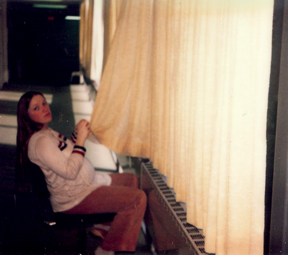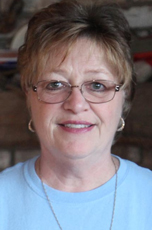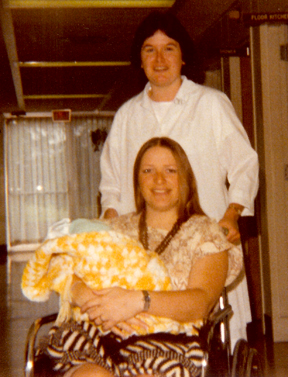Lakeside seamstress contributed to patient care and comfort
by Kristina Gabalski
 In this photo from 1979, a pregnant Betty Murphy hems hallway curtains in the area between the Visitors Desk and the Pharmacy location.
In this photo from 1979, a pregnant Betty Murphy hems hallway curtains in the area between the Visitors Desk and the Pharmacy location. Betty MurphyFor more than 80 years, Lakeside Hospital was there for members of the greater Brockport community – to help neighbors heal, stay healthy, welcome new family members into the world, and to offer sincere comfort and concern in times of tragedy and end of life.
Betty MurphyFor more than 80 years, Lakeside Hospital was there for members of the greater Brockport community – to help neighbors heal, stay healthy, welcome new family members into the world, and to offer sincere comfort and concern in times of tragedy and end of life.
The recent announcement that URMC is buying most of Lakeside’s assets and restoring outpatient care, is welcome news to the Brockport community, but many will always remember and lament the loss of an inpatient hospital.
Betty Murphy, who currently works as parish secretary at the Church of St. Leo in Hilton, worked for two-and-a-half years (1977-1979) as a seamstress at Lakeside Hospital. In her position, Betty was able to offer unique, effective, and made-to-order medical help to patients which provided tailor-made comfort and relief from pain.
Betty doesn’t remember exactly how she found out about the job, but she does remember very fondly the atmosphere and staff that made Lakeside such a special place.
“It was a wonderful place to be, a wonderful bunch of people,” Betty says. “We enjoyed each other’s company. It was a family, everybody knew each other.”
Betty had always enjoyed sewing and she still does. “It was a lot of fun,” Betty recalls of her Lakeside job. “I was in my early 20s and it was surprising to some of the doctors that I could do those things.”
Betty said her office was located on the main floor outside surgery and was well equipped. “It had a Bernina machine – boy was I spoiled – and an industrial Singer. You had to check and make sure you had all ten fingers when you were done.”
She had many tasks. In the days when nothing was disposable, she would make and repair all kinds of bedding – the kind made of “yucky hospital-green material,” Betty remembers. Bed sheets, pillow cases and “lap sheets” (laparoscopy) for surgery all needed to be made and mended.
The “lap sheets” were draped over a patient during surgery and had a hole in the middle for creating a sterile field, Betty says.
She repaired surgical outfits and when doctors kept losing their lab coats, Betty says she taught herself to do free-hand embroidery so each coat could bear the name of the doctor to whom it belonged.
Draw drapes and curtains for patient rooms needed to be made and Betty eventually ended up with fiberglass particles in her lungs from the fiberglass material that was used to make the curtains.
She then had to wear a mask, lab coat and gloves to protect herself when working with the fiberglass material. It was a bit awkward, but it sparked Betty’s sense of humor.
“I drew a face on the mask … a nose and a mouth with the tongue hanging out,” she says.
 Betty, her newborn son and OB Nurse JoAnne Dolle.But it was special projects brought to her by doctors like Dr. Sagawa and Dr. Maronian that made the greatest use of Betty’s talents and dramatically improved the comfort level of patients as they recovered.
Betty, her newborn son and OB Nurse JoAnne Dolle.But it was special projects brought to her by doctors like Dr. Sagawa and Dr. Maronian that made the greatest use of Betty’s talents and dramatically improved the comfort level of patients as they recovered.
On one occasion, Betty says she was asked by Dr. Maronian to come into the recovery room to see an elderly hip patient.
He showed her an “abduction pillow” which was trapezoidal in shape and was placed between the patient’s legs to help isolate movement following hip surgery.
Dr. Maronian envisioned a more effective design and asked Betty if she could create a similar pillow, but with concave sides which would conform better to the legs.
“I felt like MacGyver,” Betty says of sitting down in her office to figure out how to make Dr. Maronian’s vision a reality. She collected materials like foam blocks and flannel and created the new pillow which also had a removable cover to help in keeping it clean.
“Dr. Maronian used it for many years,” she said.
Another time, Dr. Maronian asked Betty for help in creating a cushion for a patient who had polio as a child. Her buttocks muscles had been moved to her abdomen in an effort to help strengthen her legs, but with no “padding left behind,” her skin was ulcerating from the friction with her bones.
The patient needed a wheelchair cushion that would take the pressure off the skin while it healed.
Betty once again got to work – using foam, and a scalpel. She measured the patient and centered two holes in the foam. She then covered the cushion with “surgical green covers.”
“This is wonderful,” the patient told Betty when she first tried the new cushion.
Dr. Sagawa also turned to Betty when a five-year-old Hamlin boy rolled down a snowbank and into the path of a dual-wheeled truck.
His torso was run-over, but miraculously he survived. Dr. Sagawa asked Betty to create a special girdle for the tiny boy that would cover the area from just below the ribs to the mid-thigh.
The boy had nothing broken or dislodged, Betty says, but the flannel/elastic/velcro girdle she constructed helped to immobilize the area and prevent swelling, aiding in the child’s recovery and also offering comfort to his worried mom and dad.
“His parents were in tears thanking me,” Betty remembers. “It was very, very gratifying.”
Betty also remembers many fun times with fellow staff members. “I was the unofficial social director,” she says, and would concoct special gag gifts for Christmas parties.
One time, she presented a certain physician, who was from another country, with a cardboard “soapbox” in honor of the fact he spent much of his lunchtime “shooting his mouth off about America,” Betty says. “Everyone but the doctor was on the floor laughing.”
She remembers company picnics and how much Dr. Sagawa loved baseball. “He would run out (of the hospital) during a break in order to bat,” Betty says. “One time, he ran right out of his shoes.”
Betty’s workshop/office was also a place where staff members could stop in for a treat. She made a special candy dispenser for her desk which allowed staff to take a candy and to make a coin donation to help keep the dish full.
An ER nurse, with whom Betty went to high school, would often show up after a frenzied time in the ER. She would remove her nurse’s cap, find a pillow Betty kept in the office, wrap it around her head to muffle the noise, and then let out an incredible scream to relieve the stress.
“She would then put her cap back on nicely, put a nickel in the candy dispenser, take a candy and go back to work,” Betty says.
During the Blizzard of 1977, Betty was able to get to her parents’ home after work, but she says many staff members “stayed and stayed and stayed,” during the days that followed. “They were troopers, they stayed with it.”
Betty worked at Lakeside until the birth of her son. He, of course, was delivered at Lakeside – by C-Section following a difficult labor.
“I was the first to come in and the last to go out,” Betty says with a laugh.
Note: Betty Murphy was also featured in a Westside News Inc. article about her project to make comforters for a retreat center in the Adirondacks.


